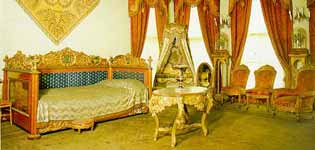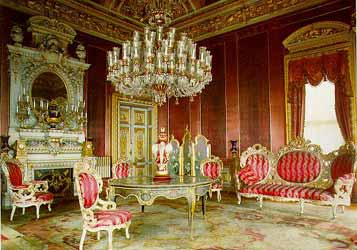|
The
palace is divided into two sections: the Ceremonial Section - where
the sultan would receive distinguished guests from all over the
world and the Harem - where the Sultan's wife, mother and concubines
lived. Apartments
of the Queen Mother project 95 meters off the harem section at
right angles, attached to the harem by the apartments of the
Crown Prince. The interior layout of Harem consists of groups of
rooms on a straight line, opening to a larger chamber, an
forming a cohesive unit. Each private bedroom of Harem opens
into a central living chamber.
Queen
Mothers Reception Room: Also called the Red Room for its
dominant colour, this room is reached though a second iron gate
at the end of the corridor leading to the harem section. On the
left at the entrance is a high gold-leafed marble
fireplace, whose framed oval mirror stretches to the ceiling.
The heavily decorated twin entry doors, frame the fireplace. Ceiling decorations are quiet unique.
Within the domed central section of the ceiling a
balconied effect is created. The four corners carry
representations of ship bows, and weapons among garlands, a
motif that carries into the bland of gold-leaf relief that
joins the ceiling to the walls. At the window side are vases on
consoles. A massive red and white crystal chandelier completes
this very rich room.
Bedroom
of the Queen Mother: The Queen Mothers bed stands on the right
of the room, gold-leafed, and elegantly canopied. Near
by is a bronze, mother-of -pearl inlaid jewellery box, made by the
shops of the Yildiz Palace 1902. Its design is in harmony with
the dominant gold as the rest of the furnishing in the room. The
ceiling is of hand engraved cloth.
Apart
from the service staircases, there are five main staircases in
the state and harem apartments. The Ambassadorial hall, the
Grand Assembly Hall, the Pink Room and the Blue Saloon are among the
most notable rooms in the palace. |


Hurrem Sultan
|
|

The room Ataturk died in |

Blue Saloon |

|
Blue
Saloon: The dominant blue colour of the
curtains, ceiling and walls in this saloon give it's name. The extensions at
either end are brightened with three windows across the sea land side. Each
section of the ceiling is framed by heavily decorated, gold-leaf massive
frames. The panels of the ceiling were mounted after being carved. Scenes of
nature and flower arrangements are featured. A red and white crystal
chandelier hangs at the centre. At the entrance, the visitors observe a pair
of mirrored consoles on the left and right. These repeat themselves at all four side entrances of the room.
The sea-side lounge is decorated in a light-coloured quilted fabric. It's
walls are colourfully engraved, with the same composition carried to the
walls on the land side lounge. The porcelain vase in the salons centre is
of Yildiz manufacture and stands on a round gold-leaf high table.
During the Republic Period, an elevator was in use. During the Abdülmecit period many receptions took place in the Blue
Room. In addition, the sultan observed his family religious holidays here,
with the company of his children and women. Abdülaziz accepted
many foreign dignitaries here. Both Abdülhamit II., and Mehmet Reshat V.,
were enthroned here and in the late years of the Sultanate, the Harem band
performed marches.
The room in which
Atatürk died: When we enter the Blue the Blue
Room, on the right we see two smaller rooms over looking the sea. The first
room was used as a study by Gazi Mustafa Kemal Atatürk, the Founder and First President of
the Republic of Turkey. The visitor notices by contrast with the
rest of the palace, the simplicity of this room. The second room, served as Atatürks bedroom, and it was here that the great revolutionary died on
November 10th, 1938. At the entrance to the bedroom on the right wall there is
a painting depicting the four seasons, much beloved by Atatürk. All of the
furnishings are of walnut, with a medicine chest along side the bed,
containing the medications last used by the late president. The decor is one
of stars and leaves, done in gold-leaf.
Pink Saloon: This room, named for its dominant
colour, was the gathering place for the women of the harem. The ceiling is of
engraved plaster. The basic decoration of the room is mirrors and consoles.
Gold-leaf and gold - threaded fabrics reflect in the mirrors. A bronze
inlaid balsam table stands on top of a huge Hereke carpet at the center of the
room. The room is lighted by the central chandelier and its matching four
floor-standing candelabras. The basic heating system of the room is through silver braziers in the corners of the room. As in the rest of the
palace, the gold-plated radiators and tile stoves were a later addition.
The
Ceremonial Hall covers an area of 2,000 square meters with 56
columns and 130 feet high ceiling. Here you can view the largest
chandelier in the world that weighs 4,5 tons bearing 750 crystals,
which was a present from the Queen Victoria of England. To heat this
enormous saloon it was necessary to begin 3 days before the event.
This section is reached by a vast hall includes the Grand Vizier's
Room and the Sheik-ul Islam's Room.
In
the Palace every square meter was decorated with the best money can buy. Bakara
crystals, approximately 600 priceless paintings by the best masters such as
Aivazovsky
of Russia
and Zonaro, grand pianos, various antique clocks, luxurious furniture, rugs and
exquisite artefacts such as huge Hereke and Isparta carpets specially
woven for Dolmabahce by famous carpet manufacturers of the city Isparta and
Hereke (a small town 50 miles, 70 kms to the east of Istanbul), porcelain vases,
Lyon silk, Venetian glasses, German and Czech Bohemian chandeliers,
skilfully crafted chairs, tables, desks and bookcases, and many more adorn
Dolmabahce Palace.
Some
rooms have a great parquet floor with three different woods inlaid
into each other by using no nails. Many of the palace fabrics and
the curtains were also coming from Hereke. The palace fabrics today
are replaced by new ones which are very similar to the original
ones.
|

Clock Tower |
Outer
grounds of the palace were completed by the additions of first, the Mosque
of the Queen Mother (of Abdülmecit) and second, the Clock Tower built by
Sultan Abdülhamit II. Additional sections and buildings were added to the
complex such as the Treasury, the Chamber of the Chief Eunuch, Glass Villa,
and opposite todays shore road the pharmacy and the Pastry Kitchens of the
palace. In addition to these, along the shore on either side of the main
palace complex, the supporting units of the sultans household stretched for
almost another kilometre, such as Carriage Houses and Stables.
Today,
in the gardens of Clock Tower; Furnishing Department, Aviary, Harem
and Heir Apparents apartment sections, cafeterias and gift shops are
open to the visitors. Introductory books about National
Palaces prepared by the Cultural Information Centre, various postcards,
reproductions of the paintings from the National Palaces Art collection
are on sale in these shops. At the same time Muayede Hall and the
gardens are allotted to national and international receptions.
|
 |
Museum contact & visiting information:
With
these new arrangements the Palace, today, is open to visitors:
- open every day except Monday and Thursday
- Opening hours are 9:30 am - 16:00
- To take
photos and videos in the palace you have to pay extra



Address: Dolmabahce, Besiktas
Telephone: +90 - 212 258 54 44 or +90-212 236 90 00
Open Hours: Open 09:30-16:00 daily, except Monday & Thursday
|